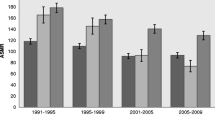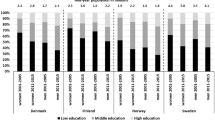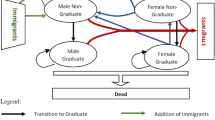Abstract
Official Swedish demographic projections have systematically underestimated the number of older people. One explanation behind the underestimation may be found in the fact that the demographic projections are not taking into account socio-economic mortality differentials. We performed alternative demographic scenarios based on assumptions of unchanged and continuing declining mortality, with and without taking into account socio-economic gradients in mortality. According to a scenario based on assumption on declining mortality rates per age group, sex and educational level, the number of older persons (65+) in Sweden will increase by 62% during the period 2000–2035. This can be compared to an increase by 54% in a scenario that does not take into account future structural differences in educational levels and the latest trends in socio-economic inequality in life expectancy (the method used by statistical offices). The socio-economic structure of the older population is significantly changing over the years. We project that by year 2035, only 20% of women 80 years and older will have a low educational level, compared to about 75–80% today. The change in socio-economic structure is similar for the older men. Standard demographic projections that do not take into account socio-economic mortality differentials, risk underestimating the number of older people and hiding dramatic changes in population composition. Taking into account socio-economic mortality differentials results in alternative projections giving us new information regarding the future size and socio-economic composition of the older population. We recommend use of this information in health care and long-term care human resources planning or when assessing financial sustainability of health care, long-term care and pension systems in the future.



Similar content being viewed by others
Notes
In this article we use the term human resources planning for both health care and social care for the older people. Other terms, related to the issue of human resources for health care and social care for the older people, used in the literature are workforce planning and manpower planning.
Data on annual decline in mortality rates (%) by age, sex and education level based on the change during the period 1992–1995 to 1996–1999 are presented in the Appendix.
References
Batljan I, Lagergren M (2004) Inpatient/outpatient health care costs and remaining years of life-effect of decreasing mortality on future acute health care demand. Soc Sci Med 59:2459–2466
Batljan I, Lagergren M (2005) Future demand for formal long-term care in Sweden. Eur J Ageing 2(3):216–224
Batljan I, Lagergren M, Thorslund M (2009) Population aging in Sweden: the effect of change in educational composition on the future number of older people suffering severe ill-health. Eur J Ageing. doi:10.1007/s10433-009-0120-1
Ben-Shlomo Y, Kuh D (2002) A life course approach to chronic disease epidemiology: conceptual models, empirical challenges and interdisciplinary perspectives. Int J Epidemiol 31:285–293
Birch S (2002) Health human resources planning for the new millennium: Inputs in the production of health, illness and recovery in populations. Can J Nurs Res 33:109–114
Birch S, O’Brien-Pallas L, Alksnis C, Tomblin Murphy G, Thomson D (2003) Beyond demographic change in human resources planning: an extended framework and application to nursing. J Health Serv Res Policy 8:225–229
Booth H, Tickle L (2003) The future aged: new projections of Australia’s elderly population. Working papers in Demography No. 90, Australian National University, Demography and Sociology Program, Canberra
Buckley JN, Denton TF, Robb AL, Spencer GB (2004) Healthy aging at older ages: are income and education important? Social and economic dimensions of an aging population. Research Papers 123. McMaster University, Hamilton, Ontario
Chernichovsky D, Markowitz S (2004) Aging and aggregate costs of medical care: conceptual and policy issues. Health Econ 13:543–562
Cutler DM (2003) Disability and the future of medicare. N Engl J Med 348:1084–1085
Cutler DM, Lleras-Muney A (2006) Education and health: evaluating theories and evidence. National Bureau of Economic Research Working Paper No. 12352
Elo IT, Preston SH (1996) Educational differentials in mortality: United States, 1979–85. Soc Sci Med 42:47–57
Erikson R (2001) Why do graduates live longer? Education, occupation, family and mortality during the 1990s. In: Jonsson JO, Mills C (eds) Cradle to grave–life-course change in modern Sweden. Sociology Press, Durham, pp 211–227
Finnish Ministry of Health and Social Affairs (1999) Sosiaali-ja terveydenhuollon tavoite-ja toimintaohjelma 2000–2003. (Target and action plan for social welfare and health care 2000–2003) (in Finnish). Julkaisuja, Helsinki 16
Freedman VA, Martin LG (1999) The role of education in explaining and forecasting trends in functional limitations among older Americans. Demography 36:461–473
Goldman DP, Lakdawalla D (2001) Understanding Health disparities across education groups. NBER Working paper 8328
Goldman DP, Smith JP (2002) Can patient self-management explain the SES health gradient? Proc Natl Acad Sci 99:10929–10934
Hollmann FW, Mulder TJ, Kallan JE (2000) Methodology and assumptions for the population projections of the United States: 1999 to 2100. Division Working Paper No. 38, Bureau of the Census, US Department of Commerce, Washington, DC
Iglesias E, Robertson E, Johansson SE, Engfeldt P, Sundquist J (2003) Women, international migration and self-reported health. A population-based study of women of reproductive age. Soc Sci Med 56:111–124
Janssen F, Peeters A, Mackenbach JP, Kunst AE (2005) Relation between trends in late middle-age mortality and trends in old-age mortality—is there evidence for mortality selection? J Epidemiol Community Health 59:775–781
Joung IMA, Kunst AE, van Imhoff E, Mackenbach JP (2000) Education, aging, and health: to what extent can the rise in educational level relieve the future health (care) burden associated with population aging in the Netherlands? J Clin Epidemiol 53:955–963
Karp A, Kareholt I, Qiu C, Bellander T, Winblad B, Fratiglioni L (2004) Relation of education and occupation-based socioeconomic status to incident Alzheimer’s Disease. Am J Epidemiol 159:175–183
Keilman N (1997) Ex-post errors in official population forecasts in industrialized countries. J Off Stat 13(3):245–277
Kirby MJL (2001) The health of Canadians—the federal role. Interim report of the Standing Senate Committee on Social Affairs, Science and Technology, vol 1. Senate of Canada, Ottawa. Available: http://www.parl.gc.ca/37/1/parlbus/commbus/senate/com-E/SOCI-E/rep-e/repintmar01-e.htm Accessed 19 January 2008
Kitagawa EM, Hauser PM (1973) Differential mortality in the United States: a study in socio-economic epidemiology. Harvard University Press, Cambridge, MA
Lagergren M, Batljan I (2000) Will there be a helping hand. Annex 8 to The Long-Term Survey 1999/2000. Fritzes, Stockholm
Lee RD, Tuljapurkar S (1997) Death and taxes: longer life, consumption, and social security. Demography 34:67–81
Lundberg O (1993) The impact of childhood living conditions on illness and mortality in adulthood. Soc Sci Med 36:1047–1052
Lutz W, Goujon A (2001) The world’s changing human capital stock: multi-state population projections by educational attainment. Popul Dev Rev 27:323–339
Lutz W, Goujon A, Doblhammer-Reiter G (1999) Demographic dimensions in forecasting: adding education to age and sex. In: Lutz W, Vaupel JW, Ahlberg DA (eds) Frontiers of population forecasting. Popul Dev Rev 24:42–58 (supplement)
Mackenbach JP (2005) Genetics and health inequalities: hypotheses and controversies. J Epidemiol Community Health 59:268–273
Mackenbach JP, Kunst AE, Cavelaars A, Groenhof F, Geurts J, EU working group on socio-economic inequalities in health (1997) Socioeconomic inequalities in morbidity and mortality in western Europe: a comparative study. Lancet 349:1655–1659
Manzoli L, Villari P, Pirone GM, Boccia A (2007) Marital status and mortality in the elderly: a systematic review and meta-analysis. Soc Sci Med 64:77–94
Marmot MG (2004) The status syndrome: how social standing affects our health and longevity. Henry Holt, New York
Marmot MG, Shipley MJ, Rose G (1984) Inequalities in death: specific explanations of a general pattern? Lancet 8384:1003–1006
Matthews R, Jagger C, Hancock R (2006) Does socio-economic advantage lead to a longer, healthier old age? Soc Sci Med 62:2489–2499
Miech RA, Hauser RM (2001) Socioeconomic status and health at midlife. A comparison of educational attainment with occupation-based indicators. Ann Epidemiol 11:75–84
Oeppen J, Vaupel JW (2002) Broken limits to life expectancy. Science 296:1029–1030
Olshansky SJ, Passaro DJ, Hershow RC, Layden J, Carnes BA, Brody J et al (2005) A potential decline in life expectancy in the United States in the 21st century. N Engl J Med 352:1138–1145
Organisation for Economic Co-operation and Development (OECD) (2003) Human resources for health care. SG/ADHOC/HEA(2003)6. Paper presented at the OECD ad hoc group meeting on the OECD Health Project, 23–25 April 2003
Osler M (2006) The life course perspective: a challenge for public health research and prevention. Eur J Pub Health 16(3):230
Pappas G, Queen S, Hadden W, Fisher G (1993) The increasing disparity in mortality between socioeconomic groups in the United States, 1960 and 1986. N Engl J Med 329:103–109
Parker MG, Thorslund M, Lundberg O, Kåreholt I (1996) Predictors of physical function—a 24 year follow-up using three outcome variables. J Aging Health 8:444–460
Ross CE, Wu C-L (1995) The links between education and health. Am Sociol Rev 60:719–745
Shryock HS, Siegel JS et al (1973) The methods and materials of demography, vol 2. Bureau of the Census, US Department of Commerce, Washington, DC
Statistics Sweden (2000) Demographic reports 2000:1. [Demografiska rapporter 2000:1 (in Swedish)], SCB, Stockholm
Statistics Sweden (2003) Demographic reports 2003:4. [Demografiska rapporter 2003:4, Sveriges framtida befolkning. Befolkningsframskrivning för åren 2003–2050. (in Swedish)], SCB, Stockholm
Statistics Sweden (2004) The Swedish register of education. SCB, Stockholm
Statistics Sweden (2005) Demographic reports 2004:4. [Demografiska rapporter 2004:4. Dödlighet efter utbildning, boende och civilstånd 1986–2003 (in Swedish)], SCB, Stockholm
Statistics Sweden (2007) http://www.scb.se/templates/Product____25785.asp or http://www.scb.se . Accessed July 2007
Sundquist K, Winkleby M, Ahlen H, Johansson SE (2004) Neighborhood socioeconomic environment and incidence of coronary heart disease: a follow-up study of 25,319 women and men in Sweden. Am J Epidemiol 159:655–662
Swedish Council for Social Research (1998) Inequality in health—a national research programme. [Ojämlikhet i hälsa—ett nationellt forskningsprogram (in Swedish)]. Socialvetenskapliga forskningsrådet, Stockholm
Swedish Ministry of Health and Social Affairs (1997) Nationell handlingsplan för äldrepolitiken. (National action plan on policy for the elderly). Stockholm: Government Bill Prop. 1997/1998:113 (in Swedish)
Swedish Ministry of Health and Social Affairs (2000) Nationell handlingsplan för utveckling av hälso och sjukvården. (National action plan for the development of health care). Government Bill Prop. 1999/2000:149, Stockholm (in Swedish)
Thorslund M, Lundberg O (1994) Health and inequalities among the oldest old. J Aging Health 6:51–69
Tuljapurkar S, Li N, Boe C (2000) A universal pattern of mortality decline in the G7 countries. Nature 405:789–792
United Nations (2003) World population prospects: the 2002 revision. Department of Economic and Social Affairs, Population Division, United Nations, New York
United States National Research Council (2001) Preparing for an aging world: the scenario for cross-national research. National Academy Press, Washington, DC
Vågerö D, Lundberg O (1995) Socioeconomic mortality differentials among adults in Sweden. In: Lopez AD, Caselli G, Valkonen T (eds) Adult mortality in developed countries. From description to explanation. Clarendon Press, Oxford, pp 222–242
Valkonen T (1989) Adult mortality and level of education: a comparison of six countries. In: Fox J (ed) Health inequalities in European countries. Gower Publishing, Aldershot, pp 142–162
Valkonen T (2001) Trends in differential mortality in European countries. In: Vallin J, Meslé F, Valkonen T (eds) Trends in mortality and differential mortality. Council of Europe, Population studies, No. 36, 2001:185–322, Strasbourg
van Hoorn W, de Beer J (1998) Long term mortality scenarios for the countries of European Economic Area. Eurostat, Working Paper 3/1998/E/No. 8, Luxembourg
van Oort FV, van Lenthe FJ, Mackenbach JP (2005) Material, psychosocial, and behavioural factors in the explanation of educational inequalities in mortality in The Netherlands. J Epidemiol Community Health 59:214–220
Wilmoth JR, Deegan LJ, Lundström H, Horiuchi S (2000) Increase in maximum life span in Sweden, 1861–1999. Science 289:2366–2368
Winkleby M, Jatulis DE, Frank E, Fortmann SP (1992) Socioeconomic status and health: how education, income, and occupation contribute to risk factors for cardiovascular disease. Am J Public Health 82:816–820
Zajacova A (2006) Education, gender, and mortality: does schooling have the same effect on mortality for men and women in the US? Soc Sci Med 63:2176–2190
Acknowledgments
We are grateful to Åke Nilsson, Gun Alm Stenflo, Jan Qvist and Hans Lundström, Statistics Sweden for supplying the mortality data, for valuable comments and careful reading of different versions of this manuscript.
Author information
Authors and Affiliations
Corresponding author
Appendix
Appendix
Assumptions on annual decline in mortality rates (%) by age, sex and education level based on the change during the period 1992–1995 to 1996–1999.
Scenario 4 | Scenario 3 | |||
|---|---|---|---|---|
Low | Medium | High | Weighted | |
Women | ||||
0–34 | 1.5 | 1.5 | 1.5 | 1.5 |
35–54 | 0.7 | 0.9 | 3.0 | 1.6 |
55–74 | 1.0 | 1.4 | 2.2 | 1.4 |
75–79 | 0.8 | 1.2 | 1.8 | 1.0 |
80–84 | 0.7 | 0.9 | 1.4 | 0.8 |
85–89 | 0.5 | 0.7 | 1.1 | 0.6 |
90–94 | 0.3 | 0.5 | 0.7 | 0.4 |
95–99 | 0.2 | 0.2 | 0.4 | 0.2 |
100 | 0.0 | 0.0 | 0.0 | 0.0 |
Men | ||||
0–34 | 1.5 | 1.5 | 1.5 | 1.5 |
35–54 | 1.9 | 2.9 | 3.0 | 2.7 |
55–74 | 2.1 | 2.1 | 3.1 | 2.3 |
75–79 | 1.7 | 1.7 | 2.5 | 1.8 |
80–84 | 1.4 | 1.4 | 2.0 | 1.5 |
85–89 | 1.0 | 1.0 | 1.5 | 1.0 |
90–94 | 0.7 | 0.7 | 1.0 | 0.7 |
95–99 | 0.4 | 0.4 | 0.5 | 0.4 |
100 | 0.0 | 0.0 | 0.0 | 0.0 |
Rights and permissions
About this article
Cite this article
Batljan, I., Thorslund, M. The effect of change in educational composition on population ageing. Eur J Ageing 6, 191–200 (2009). https://doi.org/10.1007/s10433-009-0122-z
Published:
Issue Date:
DOI: https://doi.org/10.1007/s10433-009-0122-z




